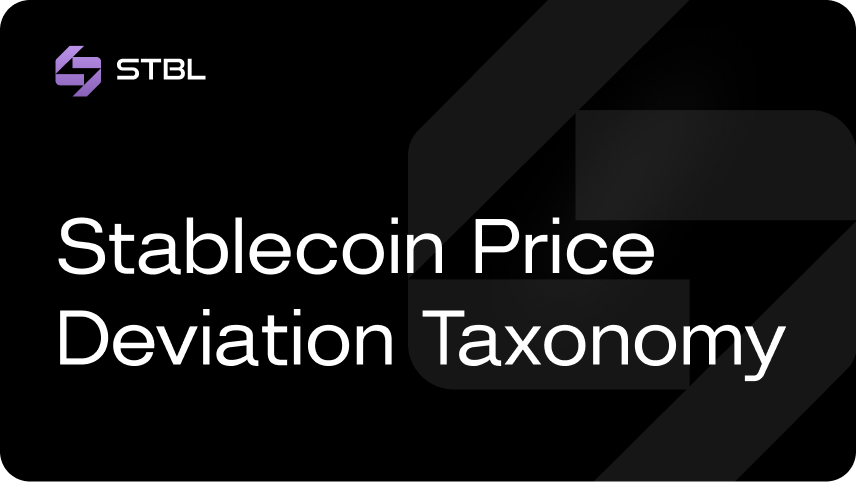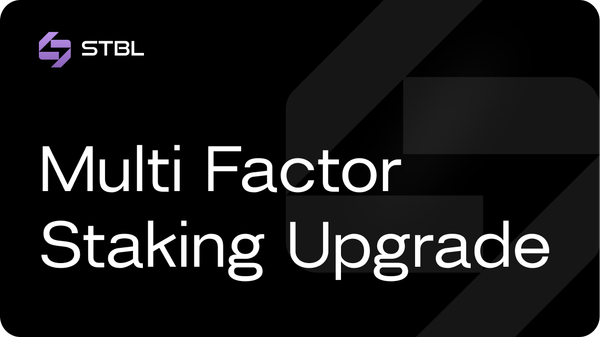Stablecoin Price Deviation Taxonomy

Utility and Risks of Stablecoins
A stablecoin cannot achieve adoption until its utility premium, the concrete functions it enables, clearly outweighs the tokenization risk inherent in wrapping real-world value on-chain.
Utility Premium (why a “digital dollar” wins)
Stablecoins provide:.
- Immediate settlement finality and 24/7 availability
- Global reach across borders and rails
- Programmability and composability with on-chain applications
- Straightforward integration for wallets, exchanges, and payment flows
- Core monetary functions: store of value, medium of exchange, privacy, etc.
Tokenization Risk (what can go wrong)
Key risk vectors for users and market participants:
- Access: Mint and burn pathways are reliably available
- Latency: Time taken, end-to-end, for mints/burns
- Cost: Fees, spreads, and slippage incurred to mint/burn
- Credibility:Viability and trust on reserves, attestations, and disclosures
- Counterparties:Exposure to third-party risk and resilience
Supply Elasticity and Market Impact (how supply changes based on demand)
If an issuer, or a trading venue, restricts or suspends mint/burn, supply can no longer expand or contract elastically. That constraint propagates across centralized exchanges, liquidity pools, and OTC networks, distorting local order books and cross-venue pricing.
Peg deviations can occur in either direction. When redemptions are unavailable or uncertain, holders may race to rotate into instruments perceived as safer or exit to fiat, amplifying discounts and draining liquidity. Conversely, when demand is strong and new issuance lags, prices can trade above par.
Sources of Deviation
Four forces jointly determine peg performance:
- Venue liquidity & microstructure (depth, routing, fragmentation)
- Market perception of the issued asset (transparency and information regarding the asset)
- Redemption frictions (queues, windows, fees, operational delays)
- Collateral viability (quality, segregation, market risk, custody, and transparency)
All four must function well to maintain a durable $1.00 tracking relationship that replicates the singleness of money.
Why Terminology Matters
“Depeg” is often used as a catch-all for any price deviation from $1. In practice, not all deviations are comparable: a brief, local single or multi-venue dislocation is categorically different from system-wide redemption stress or doubts about collateral integrity. A meaningful risk discussion distinguishes secondary-market behavior (where trading occurs) from primary-market health (where redemptions and collateral assurance reside) and classifies incidents accordingly.
Introducing “NAD” – Not A Depeg
To bring more precision to these conversations, it makes sense to propose a new term: NAD (Not A Depeg). A NAD event refers to temporary, non-systemic price deviations that do not indicate any fundamental weakness in redemption mechanics or collateral backing. These are often the result of venue-specific liquidity imbalances, technical routing issues, or short-term market perception shifts. By naming these incidents NADs, the industry can separate noise from signal - calming unnecessary panic and focusing attention on what truly matters: whether the primary market remains intact and the collateral remains sound. Not every price movement is a crisis, and calling every wobble a “depeg” only fuels confusion. NAD helps us label these episodes correctly and respond proportionately.
Two Layers of Stablecoin Pricing
Stablecoin pricing is shaped by two market layers: secondary trading and primary issuance.
- Secondary Market
- This is mostly due to exchange & liquidity pools issues such as data feeds update frequency, number of venues for access and market depth etc.
- Reflects trading activity across venues.
- Can show temporary dislocations if liquidity is thin, routing is broken, or arbitrage is restricted.
- May not always capture the true health of the stablecoin.
- Primary Market
- This is mostly issuer redemptions & collateral related issues.
- Where tokens are redeemed directly with the issuer, and this process breaks down.
- Determines whether the peg is fundamentally supported.
- If redemptions are open and collateral is intact, deviations in secondary markets are often temporary.
Price Deviation Spectrum
In addition to the two layers of stablecoin pricing (primary issuance and secondary trading), price deviations can be classified into four categories. The first two are NADs, while the latter two represent true Depegs tied to issuer dynamics.
- Local Secondary Deviation from Venue-Specific Microstructure Issues (venue level discount resulting is price deviation)
- What it is: One venue trades off-peg due to liquidity or technical factors.
- Primary health: Redemptions continue normally; collateral remains trusted.
- Analogy: A pricing glitch, not a system problem.
- Example: USDe (Oct 2025) – short-lived dislocation on a specific venue.
- Global Secondary Deviation from Market Perception (venue level discount due to market perception)
- What it is: One or more venue trades off-peg due to market perception or supply and demand issues
- Primary health: Market perception issue of assets value compared to underlying.
- Analogy: Market perception issue of assets value compared to underlying.
- Example: GYEN (Nov 2021) – stablecoin pegged to the Japanese yen and listed on Coinbase; market perception of it being like a governance token resulted in higher demand that led to price increasing above the value of underlying currency.
- Global Primary Deviation from Issuer Redemption Stress (redemption operations slow/uncertain and dependent on counterparty risks)
- What it is: Multiple venues show a discount because redemptions are delayed, restricted, or uncertain.
- Primary health: Collateral is intact, but recovery takes time. The discount reflects time-value risk.
- Analogy: A liquidity squeeze rather than a solvency problem.
- Example: USDC (March 2023) – during the SVB crisis, collateral was safe but temporarily inaccessible; or USDT (December 2024) – similarly to the USDC case, during Tether’s exit from Europe, citing unprofitable MiCA compliance requirements, led to higher USDT-to-fiat redemptions.
- Global Primary Deviation due to Collateral Viability (issuer/collateral integrity in doubt)
- What it is:The underlying collateral is questioned or impaired, and markets respond with broad-based repricing.
- Primary health: Compromised – the peg cannot be reliably defended.
- Analogy: A structural failure.
- Example: Terra/Luna (2022) – collateral model collapsed, causing permanent loss of confidence.

Why Does This Distinction Matters?
- For traders: Helps distinguish between arbitrage opportunities and systemic risks.
- For issuers: Provides clarity on whether deviations are operational, liquidity-driven, or fundamental.
- For regulators and analysts: Frames “depeg” events in a way that highlights cause, not just effect, enabling supervision of both activities and outcomes.
A Practical Vocabulary
The term “depeg” is often used too broadly, which fuels unnecessary panic and misinterpretation. By introducing more precise language, we can better classify events and respond appropriately.
This is where the concept of NAD – “Not A Depeg” comes in. Many price deviations do not signal a true depeg but are instead short-term dislocations caused by liquidity conditions, trading microstructure, or market perception. Labeling these correctly as NAD events helps the ecosystem distinguish between noise and signal, preventing confusion and restoring confidence faster.
Here’s how the new taxonomy breaks down:
- NAD (Not A Depeg):
- Local Market Deviations (1): Venue-level issues linked to liquidity or technical glitches.
- Global Market Deviations (2): Broader market perception or demand-driven imbalances, even when collateral and redemption mechanisms remain fully intact.
These scenarios do not reflect fundamental risk and should be treated as operational or market-structure issues, not true depegs.
- True Depeg Events:
- Redemption Stress (3): Slower, restricted, or uncertain redemption pathways indicating potential liquidity challenges.
- Collateral Impairment (4): Structural failures or doubts about the quality or availability of underlying reserves.
By reserving the term “depeg” exclusively for issuer-linked events (3) and (4), and classifying (1) and (2) as NAD, industry discussions become more accurate, less reactionary, and far more useful for decision-making by traders, issuers, and regulators alike.
Final Thoughts
Stablecoins are judged on their ability to maintain parity with a reference asset, but not all deviations tell the same story. By distinguishing between market-driven dislocations and issuer-linked failures, one may evaluate events more accurately and strengthen confidence in the ecosystem. This also helps issuers and market participants develop new models of operation and market stability mechanisms.




